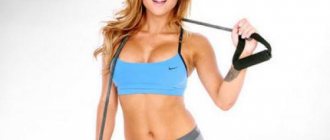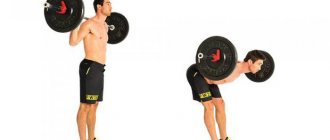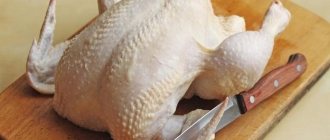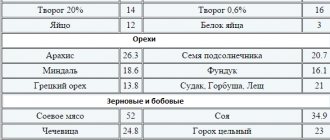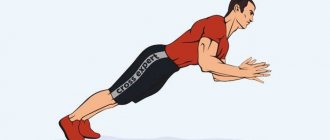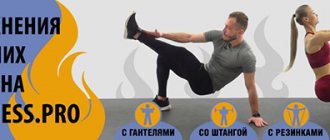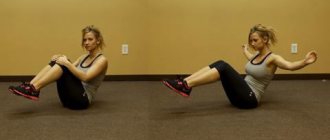Benefits of exercise
Despite its simplicity, an unsupported or supported jump provides a number of advantages. In artistic gymnastics, their mastery is mandatory, since jumps are among the basic and competitive elements.
Main benefits:
- Strengthening tendons and ligaments.
- Involvement of all muscles of the body.
- Development of movement coordination.
- Increased agility and body control.
- Preparing the musculoskeletal system to perform powerful and fast movements (including landings with strong shock absorption).
- Developing courage and determination to overcome assigned sports challenges.
In general, the vault over the goat is used as a springboard for the physical and technical development of more complex elements.
Jumping over a goat with bent legs
In order for the force of inertia to help perform such a jump, you need to have a good run-up, push off strongly, pull your legs to your chest, move them bent over the goat, land in a half-bent position, and straighten up.
At first, standing on bent legs is important. This allows you to absorb the jump and reduce the load on your knees. But in gymnastics they require a clear landing - to stand exactly on straight legs. Don't forget to lay mats around the goat just in case.
Preliminary preparation for performing this type of jump consists of the following exercises: jump in place, trying to touch your knees to your chest; from a lying position, pushing off with your feet, jump to a sitting position.
Phases of performing a vault
There are several types of jumping over a horse or goat, although they all have similar mechanics and movement phases. Mastering any type of jump is almost guaranteed to make other techniques easier to perform.
Vault phases:
- Take-off – the distance and speed of take-off depend on the height of the projectile. When performing complex techniques or unsupported jumps, the run-up distance increases significantly.
- Leap onto the bridge - carried out while reaching maximum speed. This contributes to inertial pushing and successful completion of the distance. extremely important to work with a pushing leg and accurately hit the place of the push.
- The push is an explosive element that is accompanied by swinging the arms up and forward.
- Flight is the flight phase after the push. In this phase it is important to have a steep trajectory and a slightly bent body position.
- The push with the hands is the key and most difficult phase. The push ends when the legs cross the vertical area of the supporting surface.
- Flight after repulsion - the technique depends on the type of projectile.
- Landing – requires a tuck (if you relax during landing, your balance will be worse). It is carried out by quickly rolling from the toe to the full foot. In this case, the socks are spread apart, the heels are held together.
Step-by-step instruction
To perform oblique hyperextension, you need to follow the steps below sequentially.
- The first action will be to take the starting position. You need to lie on your side and lean on your pelvis. The legs are fixed under one or different bolsters.
- A deep breath is taken with the body lowered to the lowest position.
- You should stay in this position for one second.
- Exhale, during which you need to tense the lateral muscles of the waist, as well as the thigh muscles, to rise to the starting position.
- After completing the required number of repetitions, you need to turn over to the other side and repeat all the points from the very beginning.
Preparation before execution: warm-up
Preparation is divided into two types - direct mastery of the technique of performing a vault, as well as warming up before performing the movement.
To improve and master the technique, a number of exercises are performed:
- Mastering the run-up - an athlete learns to perform a run-up. To do this, elements such as running in place (with a high hip lift), without with variable acceleration, imitation of arm movements, and others are performed.
- Jump onto the bridge - a series of jumps is performed while holding the projectile, at a height, on one leg.
- Mastering flight after take-off - performed with a partner or landing on mats.
- Push - jumping out of place, with a slight run-up, jumping back, pushing off with hands while standing against the wall.
- Mastering flight and landing - a series of jumps at different heights, half-squats and other exercises are used.
The immediate warm-up before performing the exercise includes a full range of movements. It starts with the hands, neck and shoulders with a gradual decrease until the feet are warmed up. Read more about warming up →
Stretching at this stage is excluded, as it can negatively affect not only performance, but also the risk of injury.
What is a gymnastic goat?
This jumping simulator is a leather-covered body on a steel support. The “legs” of the goat are metal stands, adjustable in height. The exercise machine is quite stable when installed even on an uneven floor. Most often found in two sizes. Dimensions of the small goat: 500*320*270 mm, large – 680*360*270 mm. Together with the legs, the height of the gymnastic goat is from 85 to 135 cm. The exercise machine can withstand a load of up to 100 kg.
To make a jump, you need to land and push off from the springy bridge. And it’s better to land on mats. Accordingly, their availability must also be taken care of in advance.
Execution technique
There are several types of techniques in which the phases depend on the position of the projectile.
Long vault jump over goat
The support jump of the legs apart over the goat is performed as follows:
- A run-up is performed, followed by a powerful kick with the legs. It is carried out simultaneously with putting your hands forward (to the place of support in the far part of the projectile).
- The body rises above the horizontal. After this, pressure is applied with both hands on the goat, bending the body and spreading the legs to the side.
- After taking off, you need to fix the deflection of the body, then raise your arms up and land.
The support jump with legs apart is considered the simplest option, therefore it is ideal for later mastering more complex elements. Performed when setting the horse in length.
Jump over a goat set wide
If the projectile is set wide, the legs are folded together and moved forward when positioned above the scanner. The landing phase is the same regardless of the technique used.
When performing an unsupported jump, the springboard may or may not be used. First, a powerful long run-up with repulsion is performed, after which the projectile flies without transferring the center of gravity to the hands. It is considered more complex than other types.
Doing hyperextension in the gym
The good thing about the gym is that it has special equipment that allows you to work out your muscles as efficiently and safely as possible. The correct technique for performing hyperextension is the key to the health of your back.
Using a goat
One of the oldest ways to pump up your lower back is to bend over a goat. We will need an ordinary sporting goat (not an animal!) and a wall bars. If there is no wall, you can ask a partner to help.
Let's look at the option with a wall:
- We place the goat so that, if you lie on it, your legs reach the bars of the wall bars.
- We lie with our pelvis face down on the goat. It is desirable that the pelvis fits completely on the sports equipment.
- We place the heels under the crossbar of the wall. There are two options: either the legs are at the same level as the head, or lower. Focus on your feelings, which leg height will be more comfortable. If your partner helps you, ask him to hold your legs firmly and prevent your body from swinging.
- We fix our hands with a cross on the chest, or behind the head. Having your hands on your chest is an easier option than having your hands behind your head. The starting position of the body is a straight line so that the spine is straightened. There is no need to arch your back, or do an exercise with a rounded back. Raise your head up (fix it in this position). We begin to lower ourselves down, bending only at the waist.
- We reach an angle of 90 degrees (perpendicular to the floor if the legs were at the same level as the body, and slightly higher if the legs were lower than the body). In case of problems with the spine, the angle may be smaller.
- We go back and unbend so that the body is in line with the legs. We linger at the top point for 1–2 seconds. We do the required number of repetitions.
If you have a partner belaying you, show him how to hold you. It will be convenient if he fixes your feet between his elbow and his torso (armpits). The goat is a tall projectile, so this is possible. With a lower apparatus, it is recommended to place the belayer on a bench.
On a machine and a Roman chair
Today, every gym is equipped with special hyperextension machines. And this is very good. In them you can pump not only your back, but also your lateral abdominal muscles and even your abs.
If for some reason there is no such exercise machine in the gym, you can use a Roman chair. The footrest is movable and can be adjusted to suit your height.
Technique for performing exercises on a hyperextension machine:
- Adjust the machine so that your pelvis rests firmly on its pad. The edge of the pillow is where your torso bends.
- We rest the back of our legs on the bolsters. You need to lie down so that the bolsters rest on the Achilles tendon, and not on the calves - girls can get bruises there too.
- We cross our arms behind our heads or on our chests. The body is an absolutely straight line.
- We make the same movements as in the previous case through the goat. We do not allow hyperextension of the back and jerking.
On a Roman chair, the exercise is performed in exactly the same way.
In some cases, after performing the exercise, girls may have bruises on their thighs. However, usually both the hyperextension machine and the Roman chair are covered with soft materials, so if performed correctly, no one will get bruises.
Jumping cost
New rules in the scoring system for rhythmic gymnastics routines provide for the replacement of elements if there is time left and the music continues to play. The basic rule is not to violate the quantity of these elements. The cost of some jumps has also been updated:
- A step with a turn and deflection previously cost 0.7 points, but now it is 0.6;
- The step jump with a turn also reduced its cost by 0.1 points and is now 0.4.
The total score for a composition can be a maximum of 20 points, 10 of which are awarded for the difficulty of the number.
Jumping over a goat with legs spread
Jumping in this way is optimal, since there is no possibility of catching the goat with your feet. Therefore, this method is the safest.
Just like in the first version of the jump, here you need to push off upside down and with your arms almost simultaneously.
Then the legs spread wide and move back. An important point: you need to remove your hands in time so as not to impede the forward movement of the body and not damage your hands and forearms. The arms move upward, and this position is maintained until the moment of landing.
It will be useful to jump separately from the simulator before performing it - to spread and close your legs when landing; the same thing - in the plank position; jump up from the plank position on your knees and swing your arms to stand with your legs apart.
When performing the first jumps, someone should help - support your hand above the elbow.
Standing long jump technique
Desire alone is not enough to learn how to jump effectively. First you need to learn the technique of long jump from a place or from a run.
Preparation before take-off
Taking the starting position is an important stage that allows you to concentrate and concentrate all your strength. Unlike the running long jump, here the initial phase is the starting line.
That is, it is necessary:
- with your feet shoulder-width apart, stand at the starting point;
- move your arms slightly behind your back (back), and lower them down with your elbows bent;
- bend the hip and knee joints at the level of the socks;
- fix your feet without lifting them off the ground.
Repulsion
The first repulsion should occur immediately after preparation. If you delay your readiness at this stage, then you will no longer be able to perform a long jump correctly from a standing position. Indeed, at this moment the torso begins inertial movement.
At the same time, during the shock period you need to have time to:
- make a sharp lunge with your hands in front of you;
- tighten the hip joints;
- straighten your legs (knees) at the joints;
- rise sharply from the ground.
Flight and landing
Correctly executed flight and landing will allow you to jump far.
During the flight you must:
- stretch your whole body to a straight line, smoothly straightening your knees;
- Before landing, lower your arms and bring your feet forward.
Contact with the surface should be easy and smooth for the jumper. For balance, knees are bent and arms are brought forward. This helps prevent injuries to the joints and their ligaments. When landing, you need to straighten up.
In addition, there are two important rules that will help you overcome the maximum distance when jumping from a standing position:
- the body should be at an angle of 45 degrees;
- You cannot land on perfectly straight legs and feet.
Flight after a push
The flight stage is one of the most important for a gymnast, as it largely influences the final assessment of the performance by the judges.
The position of your body in flight depends solely on what type of jump you are making. Immediately before landing, you should straighten your body and tense your legs as much as possible. Landing is done on your toes, and you must immediately stand on your foot. If you don't do this, you may lose your balance and fall. To soften the blow, you can try bending your legs slightly. A hard landing can lead to pain and injury.
Jumping over a gymnastic apparatus is a classic exercise from artistic gymnastics. It develops the entire body evenly, improving flexibility and balance. If you perform jumps regularly and correctly combine them with strength training, you can achieve good athletic performance and harmoniously develop your body.


